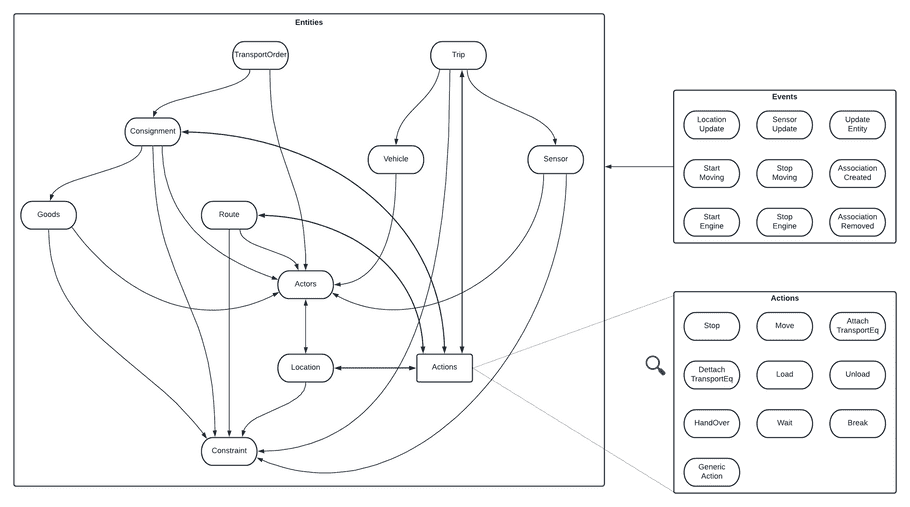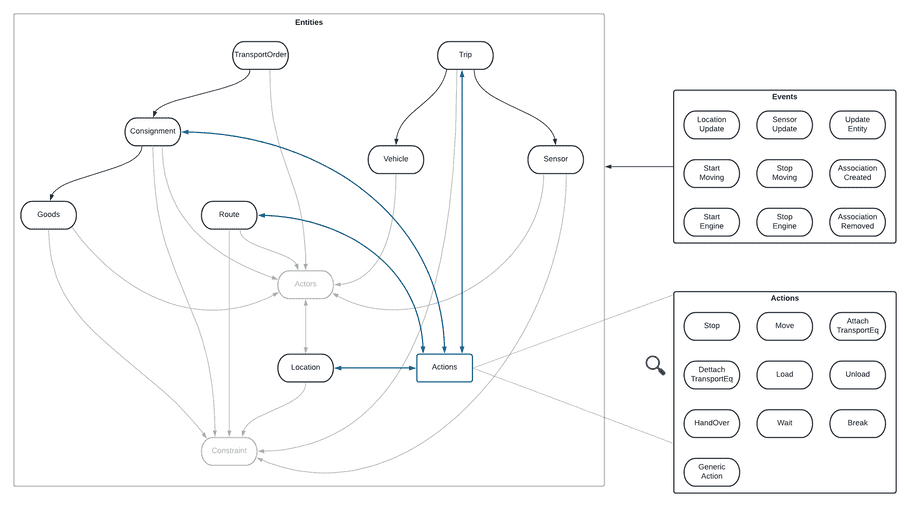Overview of Open Trip Model V5
Introduction
The fundamental idea behind the open trip model is splitting data into static data (entities) and dynamic data (actions and events) and decouple their interaction (similar to how a relational database decouples relations).
Entities contain data that changes relatively sparingly. Think for instance about consignments, locations, and vehicles. Though properties of these entities might change, this generally occurs quite rarely and is definitely not reflected in real-time.
On the other hand, how these static entities interact is more prone to change. For example, a vehicle itself remains the same height, width, and weight over its lifetime, but it can move multiple different goods every single day. Actions are used to model this interaction between entities, and events allow you to model real-time data & update previously shared data incrementally.
Design principles
- Designed for communication, not processing or as an internal format.
OTM is designed as a communication format. The intended purpose it that different parties use the same language for communicating. To meet that purpose OTM needs to be applicable in many use cases which requires great flexibility. This flexiblity can complicate the code if you process OTM internally (for example when dealing with inline vs reference associations). You are not required - or even encouraged - to completely implement the specification if doesn't fit your use cases. Focus on the parts of OTM that you need and translate between OTM and your internal format at the boundaries of your services.
- OTM is deliberately a loose format.
As mentioned, OTM tries to serve a broad spectrum of use cases in the domain of traffic and logistics, as such OTM is pretty loose in what data is required. Many fields are optional, and often data types offer multiple modelling options, such as the many georeference options available on a location. However, for your use case some fields might actually be required, even if the OTM specification makes them optional. In such cases the recommend approach is to only accept incoming OTM that you are able to process, and return validation errors otherwise. There is no reason to accept OTM, even if valid, when you are not able to process it anyway.
- The ultimate goal is to greatly reduce the amount of tailor-made software.
The loose format with many optional values allows for handling many use cases with one data model. However, it might result in two parties implementing OTM without being able to communicate automatically. To avoid this, OTM profiles were created, so that different use cases have a clear intended structure. Even so, it could still result in small discrepancies. We are continously trying to balance flexibility to enable parties to use OTM broadly, and strict rules so that the parties use OTM consistently.
Instead, we could have decided to make OTM more strict, but that would limit the real world use cases we can accurately model, without OTM becoming too bloated. We strongly believe we should strive to avoid custom software as much as possible, but that the limited amount of custom software needed to model specific use cases or OTM profiles is already a large improvement over the many custom, proprietary API formats that were needed before.
OTM Entities
Connecting all entities
Chronologically, it all starts with the TransportOrder, which groups a set of Consignments that need to be shipped from one location to another. A consignment contains various related Goods that are shipped together and administered together. Thus note that goods are actual physical entities, whereas transport orders and consignments are administrative ones. The official Documents that are related to the goods, transport orders, consignments or the delivery thereof can also be attached either as binary or with a reference to some online location.
Ultimately, consignments are moved as part of one or multiple Trips, where various Constraints can be put in place to ensure consignments are delivered on time, or always abide to a certain temperature during the trip. The transport orders and consignments can be associated with various Actors. Such as the shipper, the carrier, the consignee, consignor, or any legal party that is involved in the logistic operation.
The trip is an entity that models visiting various Locations using a single Vehicle. As such, when multiple vehicles are involved, these need to be modelled as multiple trips in OTM. Each location that is visited at a certain time is a Stop action on which multiple other actions can occur, such as Loading and Unloading of various Consignments. Other actions include Waiting - for example because the dock is still occupied - and having a Break. The big difference is that a break is always mandatory and waiting can be shorted if the situation changes.
Consignments after unloading can be (optionally) HandOver from one party (an actor) to another. If needed, you can use a Move action to model a detailed description of how to travel between two locations and which Route to take.
During a trip a Sensor in a vehicle can give LocationUpdateEvents with coordinates of the vehicle, or SensorUpdateEvents with sensor values, for example the temperature of the goods, or the speed of the vehicle. After OTM data has been shared, it can be updated using UpdateEvents with the modified data of the entities that needed to be updates. Also entities can be associated and unassociated using the AssociationCreatedEvent and AssociationRemovedEvent. This can be useful to provide or modify information of which vehicle is going to drive which trip after an initial planning has been made.
Visually
The above can be visualized as follows:

We can also use color-coding to differentiate actions and entities (blue vs black), and gray out arrows to and from actors and constraints. Since basically every entity can have some relationship to them to get the following:

This can be overwhelming, since there are so many arrows. You can even see some arrows point two ways. The OTM is thus not a tree but a graph. The reason for this setup - as we will show later on - is because it is easier to model different use cases that way.